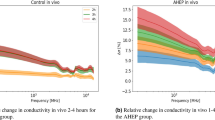Abstract
The resistivity of swine liver tissue was measured in vivo, during induced ischaemia and post-mortem, so that associated changes in resistivity could be quantified. Plunge electrodes, the four-terminal method and a computer-automated measurement system were used to acquire resistivities between 10 Hz and 1 MHz. Liver resistivity was measured in vivo in three animals at 11 locations. At 10 Hz, resistivity was 758±170 Ω·cm. At 1 MHz, the resistivity was 250±40Ω·cm. The resistivity time course was measured during the first 10 min after the liver blood supply in one animal had been occluded. Resistivity increased steadily during occlusion. The change in resistivity of an excised tissue sample was measured during the first 12h after excision in one animal. Resistivity increased during the first 2h by 53% at 10 Hz and by 32% at 1MHz. After 2h, resistivity decreased, probably owing to membrane breakdown. The resistivity data were fitted to a Cole-Cole circle, from which extracellular resistance Re, intracellular resistance Ri and cell membrane capacitance Cm were estimated. Re increased during the first 2h by 95% and then decreased, suggesting an increase in extracellular volume. Cm increased during the first 4h by 40%, possibly owing to closure of membrane channels, and then decreased, suggesting membrane breakdown. Ri stayed constant during the initial 6h and then increased.
Similar content being viewed by others
References
Astbury, J. C., Goldschmidt, M. H., Evans, S., Neibauer, G. W., andFoster, K. R. (1988): ‘The dielectric properties of canine normal and neoplastic splenic tissues’. Proceedings of 14th Northeast Bioengineering Conference, Durham, NH, March 1988
Bassi, M., andBernelli-Zazzera, A. (1964): ‘Ultrastructural cytoplasmic changes of liver cells after reversible and irreversible ischemia’,Exp. Mol. Pathol.,3, pp. 332–350
Bragós, R., Riu, P., Warren, M., Tresànchez, M., Carreño, A., andCinca, J. (1996): ‘Changes in myocardial impedance spectrum during acute ischemia in thein situ pig heart’. Proceedings of 18th Annual International Conference of IEEE Engineering in Medicine and Biology Society, Amsterdam, Paper 414
Dadd, J. S., Ryan, T. P., andPlatt, R. (1996): ‘Tissue impedance as a function of temperature and time’,Biomed. Sci. Instrum.,32, pp. 205–214
Delmas-Beauvieux, M. C., Gallis, J. L., Rousse, N., andMichel, C. P. (1992): ‘Phosphorus-31 nuclear magnetic resonance of isolated rat liver during hypothermic ischemia and subsequent normothermic perfusion,’J. Hepatol.,15, pp. 192–201
Duck, F. A. (1990): ‘Physical properties of tissue: a comprehensive reference book’ (Academic Press, San Diego, 1990)
Faes, T. J., Van Der Meij, H. A., De Munck, J. C., andHeethaar, R. M. (1999): ‘The electric resistivity of human tissues (100 Hz–10 MHz): a meta-analysis of review studies’,Physiol. Meas.,20, pp. R1-R10
Farber, J. L., Chien, K. R., andMittnacht, S. Jr. (1981): ‘Myocardial ischemia: the pathogenesis of irreversible cell injury in ischemia’,Am. J. Pathol.,102, pp. 271–281
Gabriel, C., Gabriel, S., andCorthout, E. (1996): ‘The dielectric properties of biological tissues: 1. literature survey’,Phys. Med. Biol.,41, pp. 2231–2249
Geddes, L. A., andBaker, L. E. (1967): ‘The specific resistance of biological material—a compendium of data for the biomedical engineer and physiologist’,Med. Biol. Eng.,5, pp. 271–293
Heffron, J. J., andHegarty, P. V. (1974): ‘Evidence for a relationship between atp hydrolysis and changes in extracellular space and fiber diameter during rigor development in skeletal muscle’,Comp. Biochem. Physiol.,49A, pp. 43–56
Heroux, P., andBourdages, M. (1994): ‘Monitoring living tissues by electrical impedance spectroscopy’,Ann. Biomed. Eng.,22, pp. 328–337
Konishi, Y., Morimoto, T., Kinouchi, Y., Iritani, T., andMonden, Y. (1995): ‘Electrical properties of extracted rat liver tissue’,Res. Exp. Med.,195, pp. 183–192
Kumar, N. M., andGilula, N. B. (1996): ‘The gap junction communication channel’,Cell,84, pp. 381–388
Lambotte, L. (1986): ‘Cellular swelling and anoxic injury of the liver’,Eur. Surg. Res.,18, pp. 224–229
Meyer, D. J., Yancey, S. B., andRevel, J. P. (1981): ‘Intercellular communication in normal and regenerating rat liver: a quantitative analysis’,J. Cell Biol,91, pp. 505–523
Rajewsky, B. (1938): ‘Ergebnisse der biphysikalischen Forschung’,1, pp. 77–81
Rush, S., Abildskov, J. A., andMcFee, R. (1963): ‘Resistivity of body tissues at low frequencies’,Circ. Res.,12, pp. 40–50
Schellens, J. P. M., Blange, T., andGroot, K. (1987): ‘Gap junction ultrastructure in rat liver parenchymal cells after in vivo ischemia’,Virchow Arch. B,53, pp. 347–352
Schwan, J. P. (1954): ‘The electrical characterstics of muscle tissue at low frequencies’,Z. Naturforsch,96, pp. 245–251
Steendijk, P., Mur, G., Van Der Velde, E. T., andBaan, J. (1993): ‘The four-electrode resistivity technique in anisotropic media: theoretical analysis and application on myocardial tissue in vivo’,IEEE Trans. Biomed. Eng.,40, pp. 138–148
Stoy, R. D., Foster, K. R., andSchwan, H. P. (1982): ‘Dielectric properties of mammalian tissues from 0.1 to 100 MHz: a summary of recent data’,Phys. Med. Biol.,27, pp. 501–513
Stuchly, M. A., andStuchly, S. S. (1980): ‘Dielectric properties of biological substances-tabulated’,J. Microw. Power,15, pp. 19–26
Surowiec, A., Stuchly, S. S., andSwarup, A. (1985). ‘Radiofrequency dielectric properties of animal tissues as a function of time following death’,Phys. Med. Biol.,30, pp. 1131–1141
Swatland, H. J. (1980): ‘Postmortem changes in electrical capacitance and resistivity in pork’,J. Animal Sci.,51, pp. 1108–1112
Tsai, J. Z., Cao, H., Tungjitkusolmun, S., Woo, E. J., Vorperian, V. R., andWebster, J. G. (2000): ‘Dependence of apparent resistance of four-electrode probes on insertion depth’,IEEE Trans. Biomed. Eng.,47, pp. 41–48
Zheng, E., Shao, S., andWebster, J. G. (1984): ‘Impedance of skeletal muscle from 1 Hz to 1 MHz’,IEEE Trans. Biomed. Eng.,31, pp. 477–480
Author information
Authors and Affiliations
Corresponding author
Rights and permissions
About this article
Cite this article
Haemmerich, D., Ozkan, O.R., Tsai, J.Z. et al. Changes in electrical resistivity of swine liver after occlusion and postmortem. Med. Biol. Eng. Comput. 40, 29–33 (2002). https://doi.org/10.1007/BF02347692
Received:
Accepted:
Issue Date:
DOI: https://doi.org/10.1007/BF02347692



